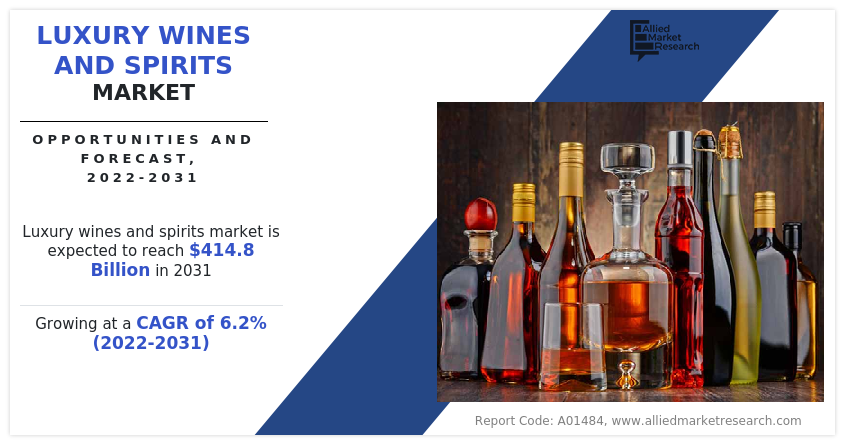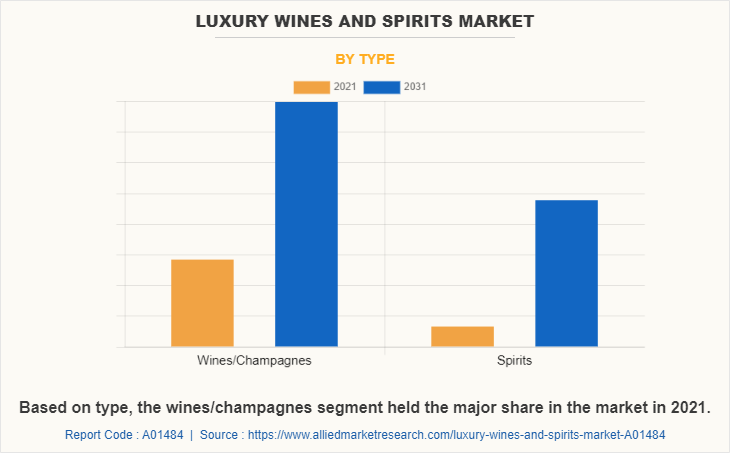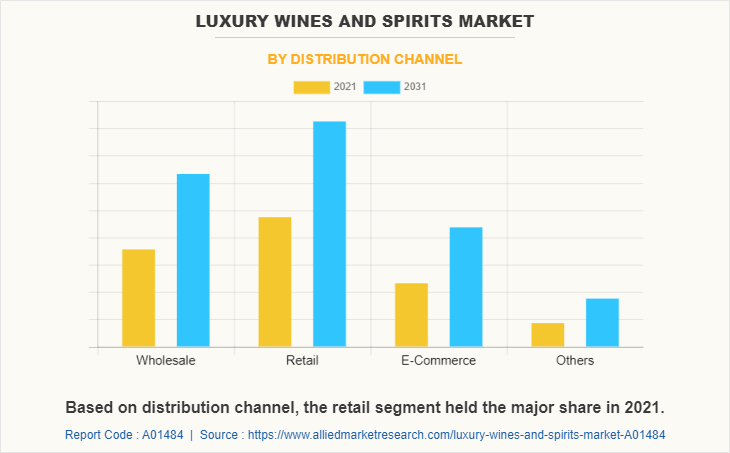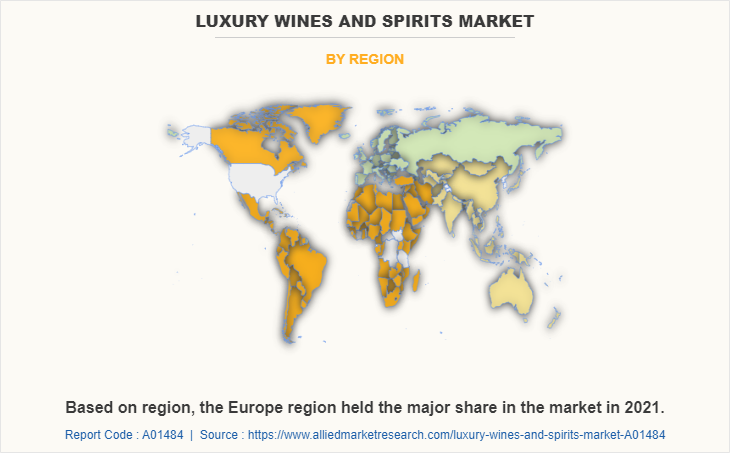Luxury Wines and Spirits Market Research, 2031
The global luxury wines and spirits market size was valued at $229.4 billion in 2021, and is projected to reach $414.8 billion by 2031, growing at a CAGR of 6.2% from 2022 to 2031.
Luxury wines and spirits market constitute alcoholic beverages having alcohol by volume (ABV) ranging from 3 to 40%. The drinks currently offered in the market are wines and distilled spirits, which are usually of fine quality and premium priced. These products are generally consumed during occasions such as marriages, parties, social gatherings, and other celebrations. They cannot be consumed by consumers aged below 17 years of age in most countries owing to government regulations. However, it is gaining popularity among middle-aged consumers, who are between 35 and 55 years of age.

Market Dynamics
Rare and vintage wines and spirits have seen an upsurge in demand due to their perceived higher value and exclusivity. Second, the desire for a distinctive and customized experience is what is behind the rise in interest in luxury wines and spirits. Customers search for goods that have a unique flavor and narrative, as well as ones that can give them a feeling of exclusivity and luxury.
Moreover, the market for luxury wines and spirits market experiences enormous growth potential as a result of the rise in demand for organic and sustainable products. The market for luxury wines and spirits is being stimulated in a number of ways by the growth in the desire for organic and sustainable goods. Customers are more concerned about their impact on the environment and look for products that are made with sustainable and ecologically friendly methods. As a result, there is a rise in demand for organic wines and spirits, which are produced from grapes farmed without the use of artificial fertilizers and pesticides. In addition, the need for authenticity and transparency drives the demand for wines and spirits that are produced sustainably. Customers are inclined to support companies that are dedicated to sustainability and ethical manufacturing methods because they want to know where and how their products are manufactured. As a result, there has been an increase in the production of biodynamic and sustainable wines and spirits, which are created using an all-encompassing method that considers the health of the land, the vines, and the environment.
Furthermore, growth in interest in wine and spirits is fuels the luxury wines and spirits market demand. Customers seek premium and distinctive products that provide a novel and exciting experience as their interest in wine and spirits grows. As a result, there is a high demand for high-end wines and spirits, which frequently have distinctive flavors, production methods, or histories. The desire of consumers to learn more about the making and history of their favorite drinks has led to an increase in the popularity of wine and spirit tourism. Wine-tasting events and vineyard tours—which frequently provide unique and expensive goods—have become more and more popular due to this. Moreover, the internet has made it easier than ever to access information about wine and spirits, and consumers can now easily purchase high-end products online. This has made luxury wines and spirits more accessible to a wider range of consumers, which further drives the demand for these products.
On the other hand, the increase in the number of high-net-worth individuals fuels the growth of the luxury wines and spirits market revenue. High-net-worth people are frequently interested in purchasing items that are unique and prominent, and luxury wines and spirits are frequently considered status symbols. As a result, there is an increase in demand for high-end wines and spirits, particularly those that are uncommon or hard to come by. Many wealthy people consider luxury wines and spirits to be wise investments with the rise in the costs of rare and vintage bottles. High-end wines and spirits have gained popularity as alternative asset classes as a result, which fuels the expansion of the luxury sector. Rich people are frequently generous gift-givers, and expensive wines and spirits are well-liked presents for milestone events like weddings, anniversaries, and holidays. The market for luxury wines and spirits has grown as a result.
In addition, there has been rapid urbanization in the past few years. As a result, the disposable income per capita has also increased. Luxury wines and spirits market growth are being fueled by rise in disposable income in a number of ways. People are inclined to spend on high-end luxury goods such as fine wines and spirits as they have more discretionary income. Premium wines and spirits have seen an increase in demand due to the perception that they are a sign of wealth and prestige. Moreover, as tastes and understanding of wines, and spirits evolve of customers, they are more prepared to pay a premium for goods with distinctive flavor profiles and premium components. The willingness of customers to pay for experiences like wine tastings, tours of wineries and distilleries, and upscale dining experiences that incorporate luxury wines and spirits have also increased as a result of rise in disposable income.
However, the luxury wines and spirits market size is severely constrained by counterfeiting. Products that are presented as authentic but are actually fake or imitation goods that fall short of the quality and standards of the original product are known as counterfeit luxury wines and spirits. The brand reputation of businesses that produce premium wines and spirits, as well as their sales and revenue, may be significantly impacted by counterfeiting. The market share of luxury wine and spirits companies may decline as a result of the sale of counterfeit goods at lower prices, which may impair consumer desire for the real thing. The risk of counterfeiting to consumers is also very high because fraudulent goods could be of subpar quality or even contain dangerous materials. Brands of luxury wines and spirits may suffer as a result of health and safety issues.
Key strategic moves and developments:-
- In January 2023, Diageo plc., announced to acquire Don Papa Rum which is a super-premium dark rum from the Philippines in order to expand its portfolio and complement its existing rums.
- In November 2022, Diageo plc., acquired Balcones Distilling which is a leading super premium whisky distiller based in Texas, the U.S., in order to expand its portfolio.
- In October 2022, Pernod Ricard announced the reinforcement of its partnership with Sovereign Brands in order to strengthen the U.S., market exposure and boosting its consumer-centric innovation.
- In November 2020, Bacardi Limited acquired TAILS which is premium crafted and batched cocktail company, in order to expand its portfolio.
Segmental Overview
The luxury wines and spirits market forecast is segmented on the basis of type, distribution channel, and region. On the basis of type, the market is classified into wines/champagne and spirits. On the basis of distribution channel, the market is classified into wholesale, retail, e-commerce, and others. On the basis of region, it is analyzed across North America (U.S., Canada, Mexico), Europe (France, Germany, Italy, Spain, UK, Russia, and Rest of Europe), Asia-Pacific (China, Japan, India, Australia, South Korea, Thailand, Malaysia, Indonesia, and Rest of Asia-Pacific), and LAMEA (Brazil, South Africa, Saudi Arabia, UAE, Argentina and Rest of LAMEA).
By Type

On the basis of type, the luxury wines and spirits industry is classified into wines/champagne and spirits. The wines/ champagne segment accounted for a major luxury wines and spirits market share in 2021 and is expected to grow at a significant CAGR during the forecast period. Consumers who have an inclination toward fine quality products rather than price drive the market growth. Consumers have become conscious of their social image and status with rise in popularity of social media platforms such as Twitter and Instagram. Thus, their aspiration to consume luxury products increases, thereby supplementing the growth of the luxury wines and spirits market.
By Distribution Channel

On the basis of distribution channel, the market is classified into wholesale, retail, e-commerce, and others. The retail segment accounted for a major luxury wines and spirits market share in 2021 in 2021 and is expected to grow at a significant CAGR during the forecast period. Growth of the retail segment in the luxury wines and spirits market can be attributed to an increase in the adoption of retail shops in both mature and emerging markets. Moreover, a one-stop solution provided by these retail formats makes it a very popular option among consumers. Furthermore, these retail formats offer a wide range of products at a competitive price to customers and are usually located in easily accessible areas, which adds to the overall attractiveness of this segment.
By Region

On the basis of region, Europe accounted for a major share of the luxury wines and spirits market in 2021 and is expected to grow at a significant CAGR during the forecast period. The Europe luxury wines and spirits market is mature and homogenous with high penetration, which is dominated by leading key players such as Campari, Bacardi, Pernod Richard, and Diageo. Changing lifestyle, owing to a considerable rise in disposable income further boosts the demand for luxury wines and spirits in Europe.
Competitive Analysis
The major players operating in the luxury wines and spirits market focus on key market strategies, such as mergers, product launches, acquisitions, collaborations, and partnerships. Brown-Forman Corporation, Pernod Ricard, Bacardi Limited, Thai Beverage PLC, Davide Campari-Milano N.V., Hitejinro co.Ltd, Suntory Holdings Limited, LVMH, Bayadere Group.
Key Benefits For Stakeholders
- This report provides a quantitative analysis of the market segments, current trends, estimations, and dynamics of the luxury wines and spirits market analysis from 2021 to 2031 to identify the prevailing luxury wines and spirits market opportunities.
- The market research is offered along with information related to key drivers, restraints, and opportunities.
- Porter's five forces analysis highlights the potency of buyers and suppliers to enable stakeholders make profit-oriented business decisions and strengthen their supplier-buyer network.
- In-depth analysis of the luxury wines and spirits market segmentation assists to determine the prevailing market opportunities.
- Major countries in each region are mapped according to their revenue contribution to the global market.
- Market player positioning facilitates benchmarking and provides a clear understanding of the present position of the market players.
- The report includes the analysis of the regional as well as global luxury wines and spirits market trends, key players, market segments, application areas, and market growth strategies.
Luxury Wines and Spirits Market Report Highlights
| Aspects | Details |
| Market Size By 2031 | USD 414.8 billion |
| Growth Rate | CAGR of 6.2% |
| Forecast period | 2021 - 2031 |
| Report Pages | 362 |
| By Type |
|
| By Distribution Channel |
|
| By Region |
|
| Key Market Players | Brown-Forman Corporation, LVMH, Bayadera Group, Thai Beverage Pubilc Company Limited, HITEJINRO Co., Ltd., Bacardi Limited, Davide Campari-Milano N.V., Pernod Ricard, Suntory Holdings Limited, Diageo plc. |
Analyst Review
According to the insights of the CXOs, the global upcycled food products market is expected to witness robust growth during the forecast period. This is attributed to the popularity of experiential marketing. The market for luxury wines and spirits is being supported in a number of ways by the rise of experiential marketing. Experiential marketing enables brands of luxury wines and spirits to connect with consumers more deeply, developing a unique and immersive brand experience. The rise in popularity of experiential marketing boosts sales of luxury wines and spirits by giving consumers memorable experiences, fostering brand loyalty, and developing distinctive and recognizable brand identities. Furthermore, to attract consumers around the globe, key players in the market invest in R&D activities and advertising & promotion of products.
CXOs further added about growth in the popularity of cocktail drinks and expanding distribution networks is further creating opportunities in the luxury wines and market of spirits. The luxury wine and spirits market has the opportunity to reach out to new customers and boost sales by expanding distribution networks. Luxury wine and spirits companies may broaden their customer base and enter new markets by collaborating with new distributors, setting up additional retail locations, and investigating e-commerce options. For instance, collaborating with new distributors may assist brands of fine wines and spirits in expanding their distribution coverage and reaching markets they might not have previously been able to access. In general, luxury wine and spirits manufacturers have a significant chance to grow their businesses and capture more market share by increasing their distribution networks. However, stringent government policies and selective distribution of products hinders the growth of the market.
The global luxury wines and spirits market size was valued at $229.4 billion in 2021, and is projected to reach $414.8 billion by 2031
The global Luxury Wines and Spirits market is projected to grow at a compound annual growth rate of 6.2% from 2022 to 2031 $414.8 billion by 2031
The major players operating in the luxury wines and spirits market include Brown-Forman Corporation, Pernod Ricard, Bacardi Limited, Thai Beverage PLC, Davide Campari-Milano N.V., Hitejinro co.Ltd, Suntory Holdings Limited, LVMH, Bayadere Group.
On the basis of region, Europe accounted for a major share of the luxury wines and spirits market in 2021
The growth in interest in premium and unique products, Rise in demand for organic and sustainable product, The popularity of experiential marketing, Rise in disposable income and rapid urbanization
Loading Table Of Content...
Loading Research Methodology...



